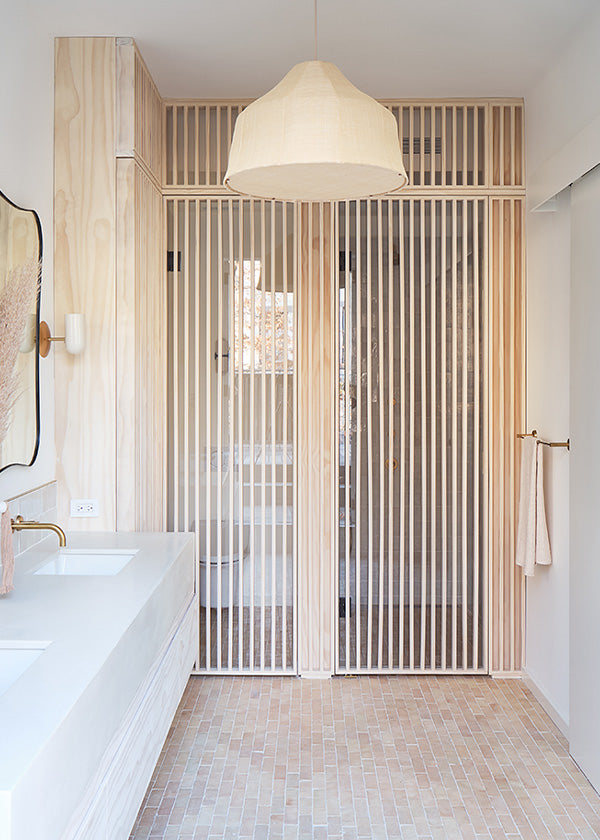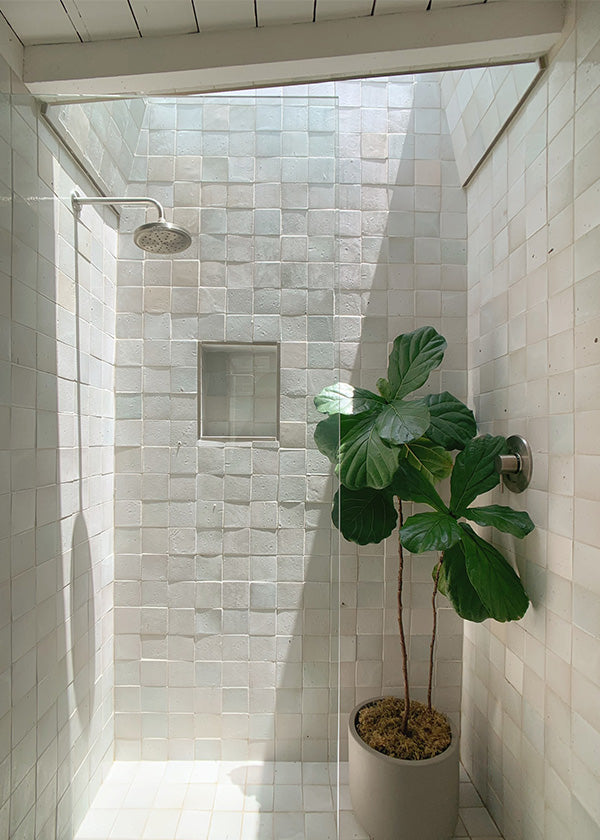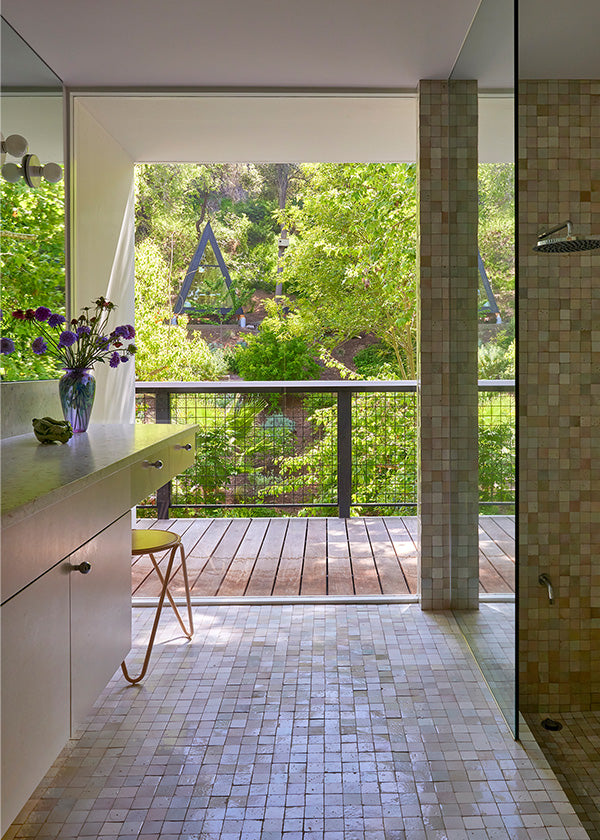design ideas for a wabi-sabi bathroom
by clé tile | published: Feb 28, 2024

wall: 4x4 zellige in natural; floor: 2x6 slate design: jamie haller / photo: jenna peffley
you could say we have a thing for handmade tile – the kind that’s made by hand using centuries-old methods, no two batches exactly the same. it’s probably why the concept of wabi-sabi feels familiar to us, with its emphasis on variation, impermanence, imperfection, patina.
if the wabi-sabi philosophy speaks to you – and beckons as the jumping off point for bathroom design – find our musings on tile, of course, along with key concepts to consider.
the wabi-sabi philosophy
many consider wabi-sabi to be merely a style or aesthetic, or even a trend, but it stretches far beyond that: it’s a philosophy and worldview deeply embedded in japanese culture, with roots in zen buddhism. it centers around concepts of imperfection, simplicity, harmony, and natural beauty.
american artist leonard koren, who helped introduce wabi-sabi to western consciousness with his book wabi-sabi for artists, designers, poets & philosophers, has described it as “material poverty, spiritual richness.”
key principles of wabi-sabi bathroom design
many key wabi-sabi principles have applications in interior design, from the bathroom to the kitchen, living room, and beyond.

2x6 eastern earthenware in rice paper design: celine ord / photo: reagan taylor

zellige 2x6 in natural design: studio fauve / photo: sarki studios
embracing imperfection
embracing imperfections is fundamental to wabi-sabi, as irregularities, cracks, and signs of wear add to the beauty of an object or space.
imagine the natural grain of a plank of wood, the uneven veining of a piece of marble or the variation and variegation in our cement, terracotta, and zellige tile.
celebrating transience
wabi-sabi acknowledges the transitory nature of all things and celebrates finding value in the present moment. nothing is ever finished or perfect, either.
natural and earth tones, love-worn objects, and natural materials all contribute to a space that celebrates transience rather than permanence or perfection.
simplicity and authenticity
leonard koren writes, “wabi-sabi is exactly about the delicate balance between the pleasure we get from things and the pleasure we get from freedom of things.” it favors simplicity over clutter and excess decoration.
in interior design, that means embracing a more minimal sensibility, including only what is essential and meaningful. it also means respecting the authenticity of the objects and materials you do incorporate, valuing them for the way they trace history and the constant transformations in nature and meaning instead of their perfection.
natural materials
no surprises here: natural materials play a starring role in any wabi-sabi minded space.
these natural materials have the imperfections inherent in nature and the passage of time, or in the alchemical changes that take place in the kiln. wabi sabi celebrates the ancient fossil in the stone, the air gaps and pits in clay and terracotta, the variation in glaze, the gentle undulations in the surface.
aging gracefully
natural materials will change and patina over time due to use or exposure to the elements. wabi-sabi embraces these changes as natural parts of the aging process that add depth and character.
stone, wood, and clay are classic materials used extensively in japan and have found themselves into wabi-sabi “style”. clé’s artisan-crafted tile celebrates the transience of natural materials – so they will patina over time (some, like cement can be refinished). wabi sabi principles (and clé) embrace and celebrate this patina, the reflection of natural evolution, the traces of a life well-lived, and the emergence of timeless beauty.
that being said, wabi sabi philosophy calls for us to not just appreciate material as it evolves and ages, but to respect it by caring for it and nurturing it – as we do our own bodies.
planning your wabi-sabi bathroom
given its focus on nature and contemplation, introducing wabi sabi principles into your bathroom scheme is an obvious point of departure.
while we’ll delve into materials below, they’re only part of the story: the other parts are how the tiles are set and installed, and finally, how they’re cared for. think of it as the trinity of tile, all working together to create not just a surface, but a work of art, a part of architecture and done right, history.
so before you even start your project, take into account all three elements.
you’ll want an experienced interior designer by your side who understands materials and can provide guidance in material choice. then make sure to hire the right contractor or tile setter. if tile will be part of your project, make sure that your contractor has plenty of experience installing handmade, artisanal tile (more on that in a moment). and finally, understand what you’re getting into. because artisan tile isn’t for everyone.

4x4 eastern earthenware tile in rice paper design: jak studio / photo: kristen juette
choosing the right tile
your tile creates the foundation for your bath – both literally and figuratively – so take the time necessary to plan your project right.
questions to ask
will tile be the hero in your bathroom, spanning from wall to wall and even extending onto the ceiling? or are you focusing on a smaller space, like the shower floor or the wall behind the sink?
whatever the area, make sure to review the material guidelines found on every product page. they go over everything from where you can use the tile (particularly important when it comes to showers) to how much care and maintenance it can take.
once you’ve zeroed in on several tiles (after reading the guidelines and resources) it’s time to order samples so you can experience a tile’s color, texture, and variation firsthand.
options, options
because wabi-sabi values imperfection and transience, we recommend looking at hand crafted options in natural materials like terracotta, terracotta, stone, and brick.
our eastern elements collection, for example, features terracotta in unique takes on the white spectrum, all with plenty of variation and iron spots for a handcrafted look.
for those wanting a dose of color (and adventure), eastern earthenware is a limited edition wood-fired terracotta tile of extraordinary richness and depth. each kiln load is utterly unique – as is each individual tile – resulting in a surface that's more art than tile.
another suggestion: guild new california, which echoes the artistry and aesthetic of california’s influential mid-century craft movement.
stone is a classic wabi sabi material: explore lapidary’s rough cut mosaics to elevated, timeless limestone and our collection of honed white marbles.
if you’re looking for something that looks distinctively aged from the start, you might want to start with travertine from our pantry pavers collection – the stone is tumbled, creating a perfect aged wabi sabi look. we think of it as giving nature a little assist.
selecting your color palette
color palettes are notoriously tricky to nail down, especially because sunlight can affect how colors appear at various times of the day. lean on your interior designer here, knowing that muted colors and earth tones like brown, green, grey, and terracotta are the most common in wabi-sabi inspired areas. beige tile in the bathroom is especially compelling.
fixtures and decor
again, your interior designer offers the best advice here. wabi-sabi is about embracing materials and objects as they age, rather than seeking out permanence and uniformity. keep this in mind when choosing your fixtures and decor.
organic textiles, brass hardware, a cracked pot, live plants, an antique stool – they’re all touches you might find in a wabi-sabi bathroom.
lighting
taking a minimalist approach helps narrow down lighting choices. the wabi-sabi aesthetic favors lights that are simple and unadorned over ones that are overly decorative or ornate. natural materials also lend a sense of authenticity here.

eastern earthenware 2x2 in rice paper design: emily farnham architecture / photo: yoshihiro makino
incorporating nature
connection to nature is central to wabi-sabi philosophy, look for ways to incorporate natural elements. live plants are one route many people take, of course, but it doesn’t stop there. natural light, earth-derived materials, natural-fiber textiles, and earthy colors all factor into this equation.
textures and fabrics
the natural world is rich in texture and variation, so it follows that a wabi-sabi inspired space would be too. work with your designer to bring this to life in your bathroom. you’ll likely find yourself gravitating towards the varying textures of wood, stone, and ceramic, along with natural fabrics like organic cotton, linen, and jute.
the marvel of clé is that all of the tile – even its more vibrant, colorful offerings – incorporate wabi sabi’s essential principles of impermanence, imperfection, authenticity, and nature. so if your love of wabi sabi is more than skin deep, your options will be almost endless.


